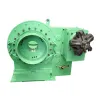Choosing a bucking unit, which is a crucial component in oil and gas drilling operations, requires careful consideration to ensure optimal performance and safety. Here are four key pieces of advice to guide you in selecting the right bucking unit:
Evaluate Capacity and Capability: Assess the capacity and capability of the bucking unit to ensure it meets the specific requirements of your drilling operation. Consider factors such as torque capacity, maximum makeup and breakout force, and compatibility with different sizes and types of tubular connections. Choose a bucking unit that can handle the range of tubular sizes and weights used in your operation, while providing sufficient torque and force to effectively makeup and breakout connections.
Consider Automation and Control Features: Look for bucking units equipped with advanced automation and control features to enhance efficiency and accuracy in makeup and breakout operations. Features such as computerized torque and speed control, torque monitoring, and data logging capabilities can improve performance, reduce human error, and provide valuable data for analysis and optimization. Additionally, consider user-friendly interfaces and intuitive controls to facilitate operation and maintenance.

Prioritize Safety and Reliability: Safety and reliability are paramount when choosing a bucking unit for drilling operations. Select units with robust safety features, such as emergency stop buttons, overload protection, and automatic shut-off mechanisms, to prevent accidents and protect personnel and equipment. Additionally, prioritize units from reputable manufacturers with a proven track record of reliability and durability in demanding drilling environments. Regular maintenance and inspection are also essential to ensure continued safe and reliable operation.
Consider Adaptability and Integration: Choose a bucking unit that can easily integrate with existing drilling equipment and systems, and adapt to changing operational requirements. Consider factors such as mounting options, power requirements, and compatibility with control systems and software used in your operation. Units with modular designs and flexible configurations can facilitate integration and scalability, allowing for seamless operation and future upgrades as needed.
By following these pieces of advice and carefully evaluating capacity, automation features, safety, reliability, adaptability, and integration capabilities, you can choose a Customized Hydraulic Bucking Unit that meets the specific needs of your drilling operation and contributes to efficient, safe, and successful drilling activities.
Previous: Welded Vs Seamless Stainless Steel Tubing
Next: None
Related Articles
Comments
Please Join Us to post.
0